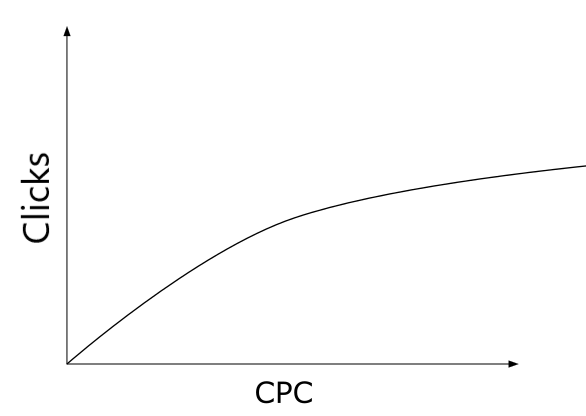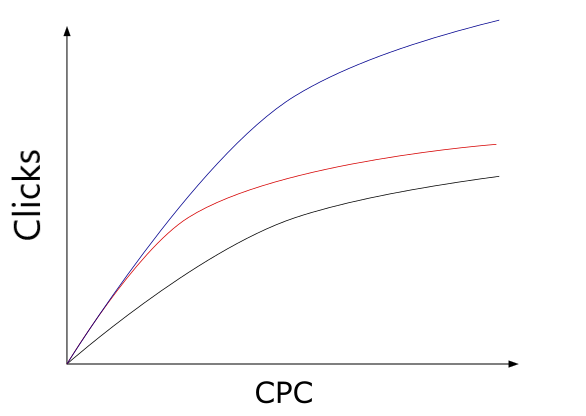Start Exploring Keyword Ideas
Use Serpstat to find the best keywords for your website
How To Optimize Contextual Advertising: Tricks And Lifehacks



But here it all depends on how much stronger or weaker you are than your competitors:
What happens if we suddenly get a 50% discount? With any CPC, we get the same number of clicks that we got with CPCx2.

As you can see, at low rates, the efficiency is the same. But with high bids, the blue graph seems better. It is not only higher but also allows you to buy the same number of clicks cheaper.
All optimization methods can be divided into 3 types:
Negative Keywords = СTR - Reach = (Reach + Discount) - Reach = Discount
Therefore, increasing the CTR by negative keywords is three times less effective than increasing the CTR by writing more relevant texts.
How To Launch A Successful Advertising Campaign: 10 Lifehacks of API Console
The advantages of this approach are that it's usually enough to increase reach once, but CTR, bids, and negative keywords can be improved indefinitely. Therefore, we will almost immediately get rid of one of the tasks.
If you have several advertising systems, then it's best to do this:
These include:
If you use substitution, add as many subqueries of your keyword as possible to the group. For example, you have the keyword "bag". As a result, out of 33 characters of the title, you use only 3. And if you add the subqueries "Buy a bag", "Buy an eco-bag," and "Buy a leather bag," then the length of the title and the amount of text in bold will increase.
To find subqueries you can use several tools:

Also, studying the subqueries will help you understand what users care about (prices, guarantees, delivery) and collect negative keywords.
The final CTR will be about the same as the best ad in the group. It, in turn, depends on 3 factors:
If you have another PPC specialists in your office, then ask them to write one ad per group. Do the same in return. Perhaps we will have new ideas that work better.
You can also borrow ads from your competitors. For example, from other regions.
You can do it with Serpstat. Go to Keyword Research → PPC Research → Keyword Selection. This report allows you to see the list of ads and paid keywords from Google top-100 results.



It is essential to lead customers to the correct landing page so that they don't get lost on your site.
To increase conversion, you must first study the competitors.

Some companies make individual landing pages for PPC, and you can access them only through ads. To find them, you can manually enter your keywords into search engines or find all domain ads via the report Site Analysis → Domain Analysis → PPC Analysis → Keywords.
Example of segmentation by clusters:
You can also group data on landings and get data on traffic using API console.
These popups, often called exit offers, are great for capturing leads or giving users one last incentive, like a discount or free resource, before they leave.

You can use two options for implementing pop-ups: use online services (for example, poptin.com) or write the code yourself and when the user exits, show the pop-up that already exists.
How To Get Ahead Of The Largest Advertisers In The Market: PPC SERP Crawling
Serpstat report Keyword Analysis → SEO Analysis → Related Keywords can also help you. You can use filters to remove misspelled keywords and sub-queries of your keyword.


To do this, go to the report Behavior → Site Content → Landing Pages. It shows statistics on landing pages from all sources.

Keywords by which this page is ranked can be found in the Serpstat report Site Analysis → URL Analysis → Keywords. You can also check missed page semantics. Therefore, we go to the report Site Analysis → URL Analysis → Missing Keywords.
The AdWords Keyword Planner hides some of the words, so you need to use additional tools. AdWords also doesn't understand the morphology of negative keywords.
A couple of weeks after the launch of the ad, look at which search queries your ads were shown. Thus, you will expand the list of negative keywords.
Read here how to collect semantics for advertising:
How To Do Keyword Research For Contextual Advertising And Get Maximum Outreach
When you collect statistics, then you can calculate the bids based on it. For example, to optimize conversions, you can calculate bids using the following formula:
Bid = k × ((conversion +1.5) ÷ (clicks +1.5÷m))
Where:
* conversion is the average of the site.
* k is a constant, a common factor to fit into the conditions: if your goal is to maintain an average CPA, then k is slightly larger than your target CPA. If your goal is maximum profit, then k is equal to the conversion value.
Speed up your search marketing growth with Serpstat!
Keyword and backlink opportunities, competitors' online strategy, daily rankings and SEO-related issues.
A pack of tools for reducing your time on SEO tasks.
Discover More SEO Tools
Keywords Grouping
Streamline your SEO efforts with our advanced clustering keywords tool
Search Google Trends
Unlock the power of your target audience's searched keywords with our keyword trends
Keyword Volume Checker
Bulk Keyword Volume Checker – get valuable information about your target keywords
Tools for Keywords
Keywords Research Tools – uncover untapped potential in your niche
Recommended posts
Cases, life hacks, researches, and useful articles
Don’t you have time to follow the news? No worries! Our editor will choose articles that will definitely help you with your work. Join our cozy community :)
By clicking the button, you agree to our privacy policy.
